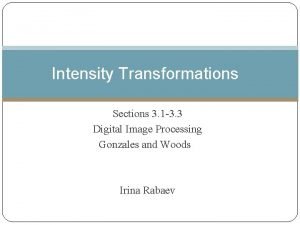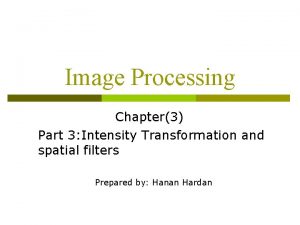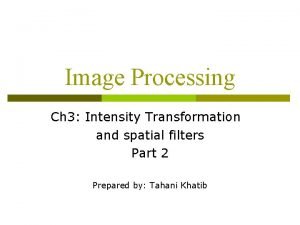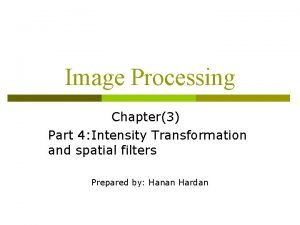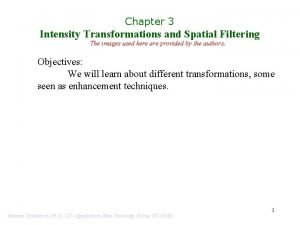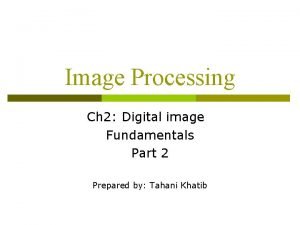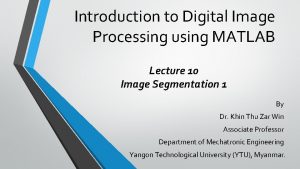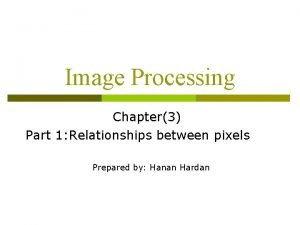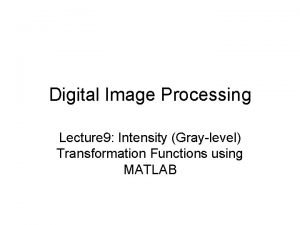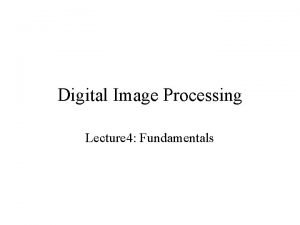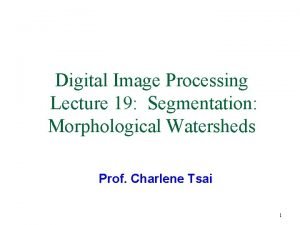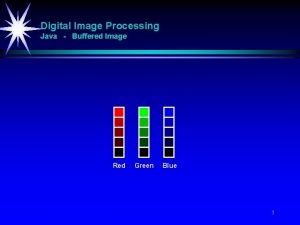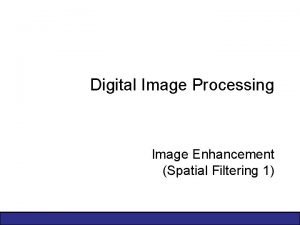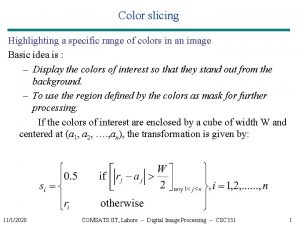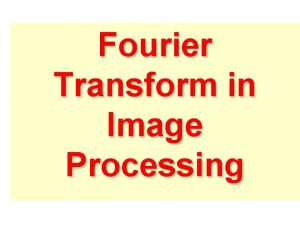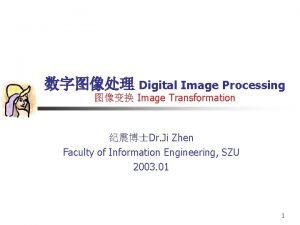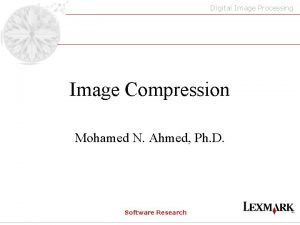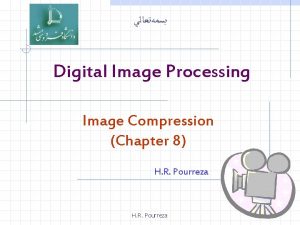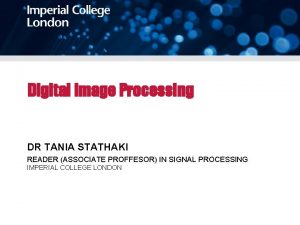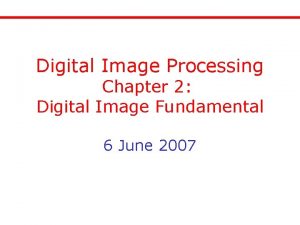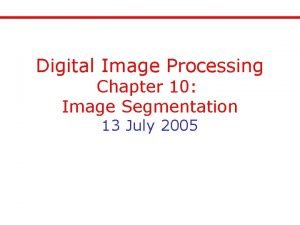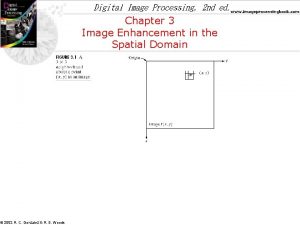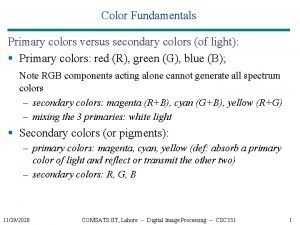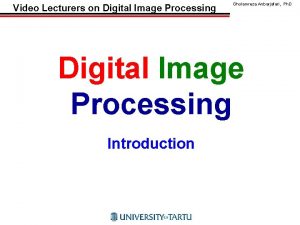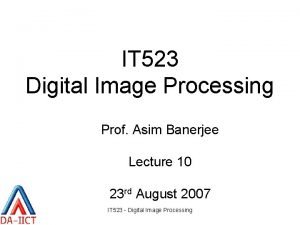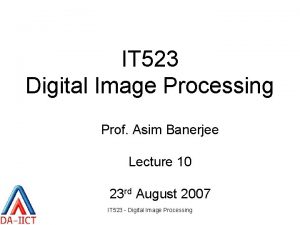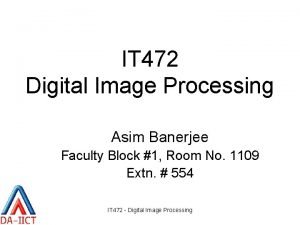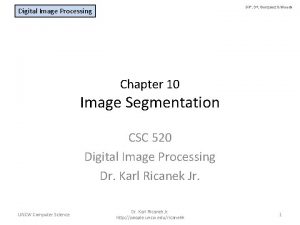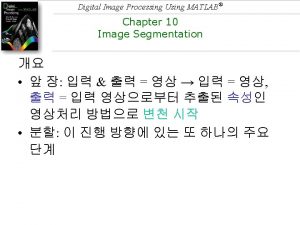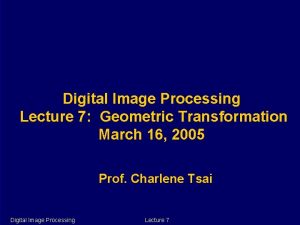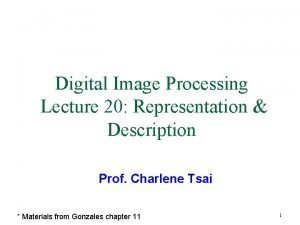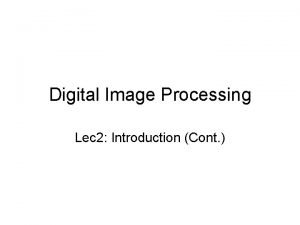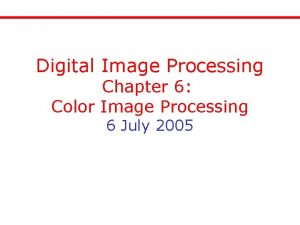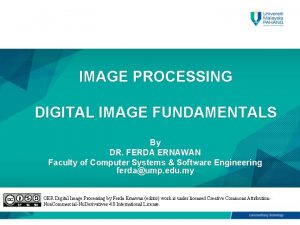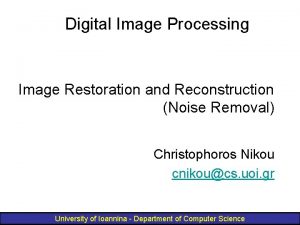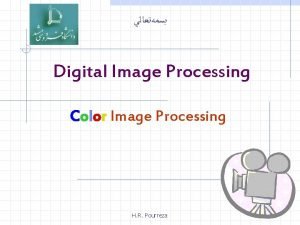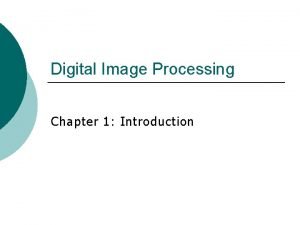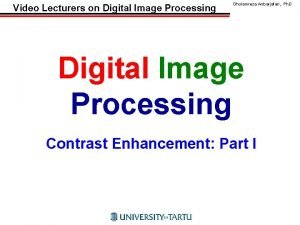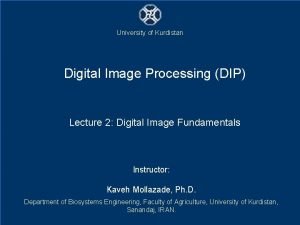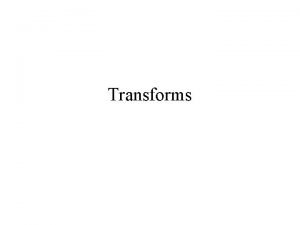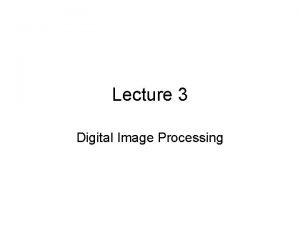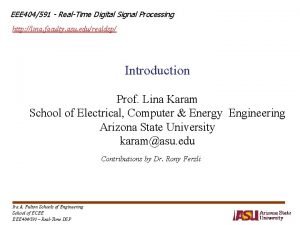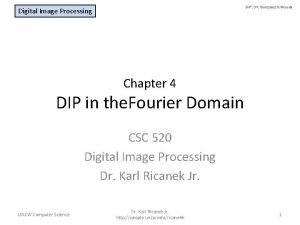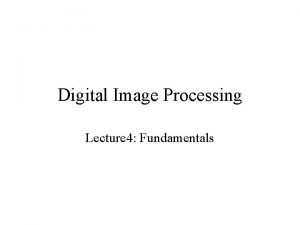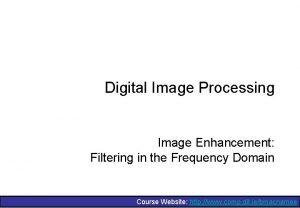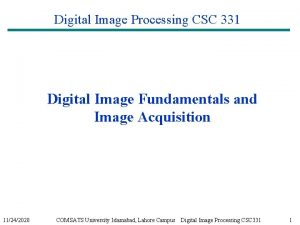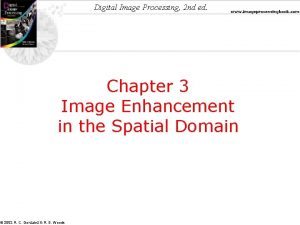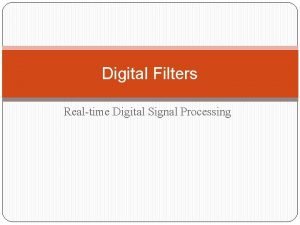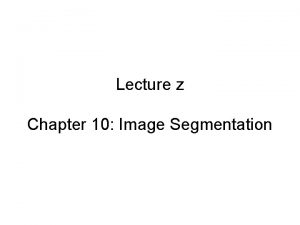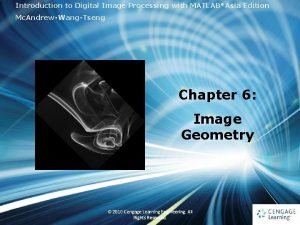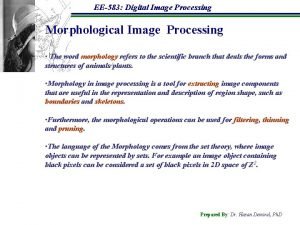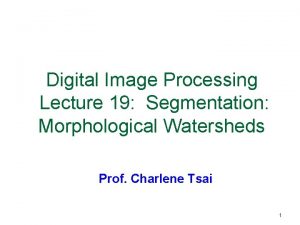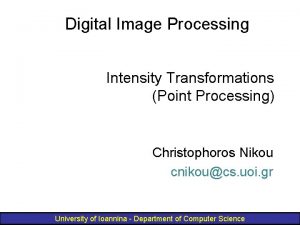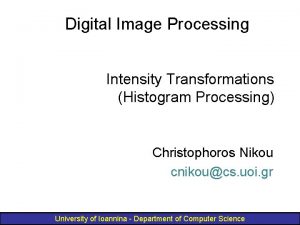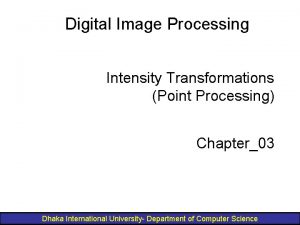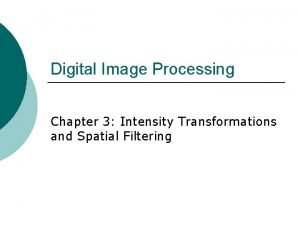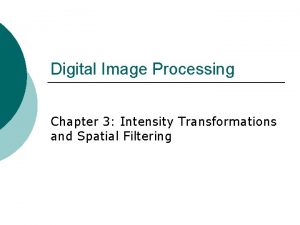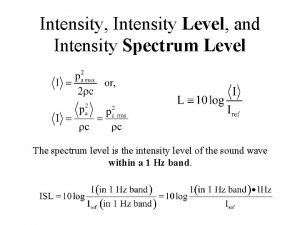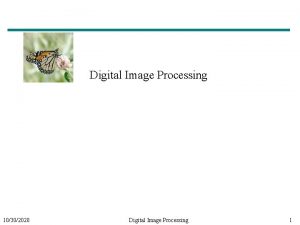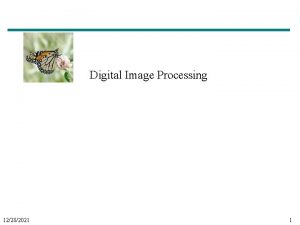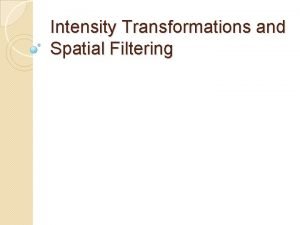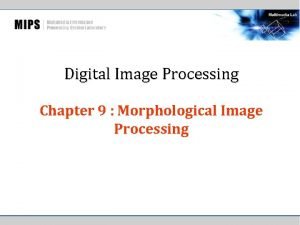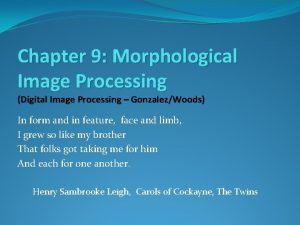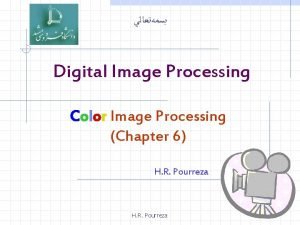Digital Image Processing Chapter 3 Intensity Transformations and





























































































- Slides: 93

Digital Image Processing Chapter 3: Intensity Transformations and Spatial Filtering

Background ¡ Spatial domain process l where is the input image, is the processed image, and T is an operator on f, defined over some neighborhood of

¡ Neighborhood about a point

¡ Gray-level transformation function l where r is the gray level of s is the gray level of point and at any

¡ Contrast enhancement l For example, a thresholding function

¡ Masks (filters, kernels, templates, windows) l A small 2 -D array in which the values of the mask coefficients determine the nature of the process

Some Basic Gray Level Transformations

¡ Image negatives l Enhance white or gray details

¡ Log transformations l Compress the dynamic range of images with large variations in pixel values

l From the range 00 to 6. 2 to the range

Power-law transformations ¡ or ¡ l l maps a narrow range of dark input values into a wider range of output values, while maps a narrow range of bright input values into a wider range of output values : gamma, gamma correction


¡ Monitor,



¡ Piecewise-linear transformation functions l The form of piecewise functions can be arbitrarily complex

l Contrast stretching

l Gray-level slicing


l Bit-plane slicing





Histogram Processing ¡ Histogram l l where is the kth gray level and the number of pixels in the image having gray level Normalized histogram is


¡ Histogram equalization


l Probability density functions (PDF)








¡ Histogram matching (specification) is the desired PDF



¡ Histogram matching l l l Obtain the histogram of the given image, T(r) Precompute a mapped level for each level Obtain the transformation function G from the given Precompute for each value of Map to its corresponding level ; then map level into the final level








¡ Local enhancement l Histogram using a local neighborhood, for example 7*7 neighborhood

l Histogram using a local 3*3 neighborhood

¡ Use of histogram statistics for image enhancement l l l denotes a discrete random variable denotes the normalized histogram component corresponding to the ith value of Mean

l The nth moment l The second moment

l l Global enhancement: The global mean and variance are measured over an entire image Local enhancement: The local mean and variance are used as the basis for making changes

l is the gray level at coordinates (s, t) in the neighborhood is the neighborhood normalized histogram component mean: l local variance l l

l l are specified parameters is the global mean is the global standard deviation Mapping




Fundamentals of Spatial Filtering ¡ The Mechanics of Spatial Filtering

l l Image size: Mask size: and



¡ Spatial Correlation and Convolution


¡ Vector Representation of Linear Filtering

Smoothing Spatial Filters ¡ Smoothing Linear Filters l l l Noise reduction Smoothing of false contours Reduction of irrelevant detail





¡ Order-statistic filters l l median filter: Replace the value of a pixel by the median of the gray levels in the neighborhood of that pixel Noise-reduction


Sharpening Spatial Filters ¡ Foundation l The first-order derivative l The second-order derivative



¡ Use of second derivatives for enhancement-The Laplacian l Development of the method




l Simplifications


¡ Unsharp masking and highboost filtering l Unsharp masking ¡ ¡ Substract a blurred version of an image from the image itself : The image, blurred image : The

l High-boost filtering



¡ Using first-order derivatives for (nonlinear) image sharpening—The gradient

l The magnitude is rotation invariant (isotropic)

l Computing using cross differences, Roberts cross-gradient operators and

l Sobel operators ¡ A weight value of 2 is to achieve some smoothing by giving more importance to the center point



Combining Spatial Enhancement Methods ¡ An example l l Laplacian to highlight fine detail Gradient to enhance prominent edges Smoothed version of the gradient image used to mask the Laplacian image Increase the dynamic range of the gray levels by using a gray-level transformation


 Intensity transform functions
Intensity transform functions Intensity transformation
Intensity transformation Gray level slicing in image processing
Gray level slicing in image processing Intensity level slicing in digital image processing
Intensity level slicing in digital image processing Histogram processing in digital image processing
Histogram processing in digital image processing Neighborhood averaging in image processing
Neighborhood averaging in image processing Nonlinear image processing
Nonlinear image processing What is point processing in digital image processing
What is point processing in digital image processing Point processing operations in image processing
Point processing operations in image processing Digital image processing
Digital image processing Image transform in digital image processing
Image transform in digital image processing Linear position invariant degradation
Linear position invariant degradation Spatial and temporal redundancy in digital image processing
Spatial and temporal redundancy in digital image processing Key stages in digital image processing
Key stages in digital image processing Huffman coding example
Huffman coding example Image sharpening and restoration
Image sharpening and restoration Image geometry in digital image processing
Image geometry in digital image processing Steps in digital image processing
Steps in digital image processing Digital image processing
Digital image processing Maketform matlab
Maketform matlab Noise
Noise Intensity transformations and spatial filtering
Intensity transformations and spatial filtering Intensity transformations and spatial filtering
Intensity transformations and spatial filtering Intensity transformation and spatial filtering
Intensity transformation and spatial filtering Intensity transformations and spatial filtering
Intensity transformations and spatial filtering Intensity transformations
Intensity transformations Representation and description in digital image processing
Representation and description in digital image processing For coordinates p(2,3)the 4 neighbors of pixel p are
For coordinates p(2,3)the 4 neighbors of pixel p are Representation and description in image processing
Representation and description in image processing Pattern and pattern classes in image processing
Pattern and pattern classes in image processing Analog image and digital image
Analog image and digital image Image representation and description
Image representation and description Double thresholding in image processing
Double thresholding in image processing Segmentation in digital image processing
Segmentation in digital image processing The distance between pixels p and q
The distance between pixels p and q Imadjust
Imadjust A pixel p at coordinates
A pixel p at coordinates Coordinate conventions in digital image processing
Coordinate conventions in digital image processing Dam construction in digital image processing
Dam construction in digital image processing Digital image processing java
Digital image processing java Thresholding in digital image processing
Thresholding in digital image processing Segmentation in digital image processing
Segmentation in digital image processing In digital image processing
In digital image processing Optimum global thresholding using otsu's method
Optimum global thresholding using otsu's method Regional descriptors in image processing
Regional descriptors in image processing Colour slicing
Colour slicing Fourier transform in image processing
Fourier transform in image processing Digital image processing
Digital image processing Digital image processing
Digital image processing Haar transform for n=8
Haar transform for n=8 Coding redundancy in digital image processing
Coding redundancy in digital image processing Jpeg in digital image processing
Jpeg in digital image processing Digital image processing
Digital image processing Mach band effect in digital image processing
Mach band effect in digital image processing Digital image processing
Digital image processing Digital image processing
Digital image processing Color fundamentals in digital image processing
Color fundamentals in digital image processing Image processing
Image processing Digital path in image processing
Digital path in image processing Digital path in image processing
Digital path in image processing Lossless compression in digital image processing
Lossless compression in digital image processing Digital image processing
Digital image processing Houghpeaks matlab
Houghpeaks matlab Geometric transformation in digital image processing
Geometric transformation in digital image processing For a chain code 10103322
For a chain code 10103322 Components of image processing
Components of image processing Intensity level resolution
Intensity level resolution Full colour image processing
Full colour image processing Oerdigital
Oerdigital Digital image processing
Digital image processing Image processing
Image processing Image processing
Image processing Origins of digital image processing
Origins of digital image processing Digital image processing
Digital image processing Image processing
Image processing Hadamard transform in digital image processing
Hadamard transform in digital image processing Aliasing in image processing
Aliasing in image processing Shape numbers in digital image processing
Shape numbers in digital image processing Digital processing
Digital processing Image processing
Image processing Coordinate conventions in digital image processing
Coordinate conventions in digital image processing Processing
Processing Digital image processing
Digital image processing Image processing
Image processing Digital image processing
Digital image processing Signal processing filter
Signal processing filter Piecewise linear transformation in digital image processing
Piecewise linear transformation in digital image processing Dam construction in digital image processing
Dam construction in digital image processing Introduction to digital image processing with matlab
Introduction to digital image processing with matlab Morphological operations in image processing
Morphological operations in image processing Watershed morphology
Watershed morphology Primary food production
Primary food production Batch processing and interactive processing
Batch processing and interactive processing Chapter 15 cultural transformations
Chapter 15 cultural transformations

